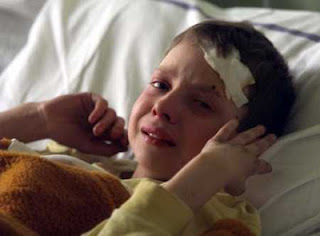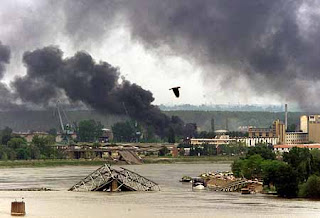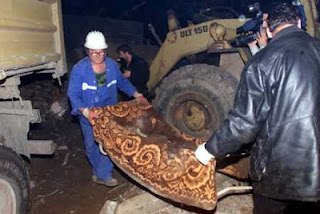Since the Nato airstrikes began on March 24 more than 2,500 civilians have been killed and more than 7,500 wounded.
 |
| An injured Serb boy, Marko Miladinovic, cries in his hospital bed in Aleksinac AP Photo/Srdjan Ilic |
Nato has owned up to bombing raids and missile attacks that have killed 460 civilians, according to a tally by Agence France-Presse. By all accounts, the bombing was indiscriminate, killing farmers, suburbanites, city dwellers, factory workers, reporters, diplomats, people in cars, busses and trains, hospital patients, the elderly and children.
Indeed, by our count, Nato bombing raids have killed more than 200 children. Hundreds more will almost certainly perish in the coming months, through environmental factors, such as poisoned water supplies and lack of electrical power to run vital hospital equipment. The following list of civilian casualties is far from comprehensive. We compiled it from daily reports by the Yugoslav Foreign Ministry and wire services, including Agence France Presse, Reuters and AP.
Aleksinac
Five Nato missiles hit Aleksinac, a small mining community, on April 6. Seventeen civilians, taking shelter in a basement of a house, were all killed. Although there is no military presence in the residential area that was bombed, more than 400 homes were destroyed.
Ariljaca
Nato missiles hit Ariljaca, a small town outside Pristina, on April 28, killing two and injuring a dozen civilians.
Belgrade
Near midnight on June 1, 14 missiles destroyed a block of houses in a suburb of Belgrade killing 5 and injuring 20.
Around 1 a.m. on May 20, Nato cluster bombs hit “Dragisa Misovic” hospital in downtown Belgrade. The neurological ward, the maternity ward, the gynecological ward and the children’s ward for lung diseases were destroyed. Nato later admitted that one of the laser guided bombs overshot its target by about 1,500 feet (460 meters).
During the attack 4 women were in active labor. A woman who, at the time of the attack, was having a Caesarean section, was also injured. She was transferred to the basement where her baby was finally delivered! In the attack 4 patients were killed, and several women in labor were wounded.
On May 8, Nato airstrikes hit the Chinese Embassy, destroying half of the building. According to the Chinese Government there were about 30 people in the building at the moment of the attack. Four Chinese citizens were killed and at least 20 injured.
On Friday, April 23, around 2 a.m., the building of the Serbian National Broadcasting Network was destroyed by Nato air strikes. The building is in the very center of Belgrade, a few hundred feet from a children’s theater, St. Marko’s Church, the City Childrens Center and the local market. More than 20 civilian employees of the TV station were killed.
On April 16, Milica Rakic,(January 9, 1996 — April 17, 1999) a three-year-old girl, was killed in the Nato attack on Batajnica, a residential suburb of Belgrade.
 |
| Milica Rakic,( a three-year-old girl, was killed in the Nato attack on Batajnica, a residential suburb of Belgrade |
The administrative center of the Ministry of Internal Affairs was hit several times. The building is in the very center of Belgrade, near the city hospital, which has the largest delivery ward in Belgrade. Several civilians, who were passing by the building at the time of the attack, were killed.
On April 13, a cluster bomb hit the Veterans Army Hospital in downtown Belgrade, injuring sixteen patients.
Bor
Bor
Six persons were wounded when Nato hit the electricity relay station at a mine site in Basin Bor on May 15.
Cacak
Cacak
On May 5, Nato forces destroyed the Sloboda plant, the largest factory in Cacak. This factory produced domestic appliances and employed 5,000 workers. A residential area near the factory was also destroyed. Two persons were killed, one of them was a 74-year-old woman. Seven were injured.
 |
| Radenko, left, and Mileka Prtenyakovic, cry in what remains of their home in the city of Chachak (AP Photo/ITAR-TASS) |
Cuprija
On June 1, 2 civilians were killed and 9 wounded when Nato bombs destroyed more than 100 houses in the center of this small town.
Djakovica
On April 21 70 civilians died and 20 were injured in a refugee camp near Djakovica, home for more than 500 people evicted from Krajina (Croatia). The houses were completely destroyed. Just four years ago, more than 400,000 civilian Serbs were ethnically cleansed from the Krajina region by the Croatian government of Franjo Tudjman. There were 53 bomb craters at the site.
On April 19, seven missiles hit the same site, killing five and wounding 16.
Gnjilane
Gnjilane
Nato attacked Gnjilane a number of times in May. There were dozens of civilian casualties. The City Hospital was hit and badly damaged.
Grdelica
Nato hit an international train, on regular service from Belgrade to Thessaloniki (Greece), in the vicinity of Leskovac on Monday, April 12. Sixty passengers were killed, including a 10 year-old child. More than 30 passengers were wounded. All casualties were civilians.
Gucevo
On April 23, Nato planes attacked this mountain ski resort, seriously injuring the manager of the complex.
Istok
On May 21, a prison in Istok was hit with two missiles, killing one man and seriously injuring one woman. The attack was repeated at 9:20 a.m. with ten missiles. The econd attack left nine people dead, including the deputy governor. At least 10 people were injured. Since then, Nato has bombed this prison several times. By June 1, the death toll had risen to 100..
Jagodina
On May 25, Nato attacked this agricultural village with five missiles. One struck a greenhouse killing a farmer and wounding two workers.
Kragujevac
Workers employed at the Zastava factory in Kragujevac used their bodies to “protect” the factory, a fact that was well known to Nato war planners. 120 workers were injured in an April 10 Nato assault on the factory. The Zastava automobile factory supported more than 50 percent of the citizens living in the Kragujevac area.
Kraljevo
On June 1, seven people were injured, three of them children, when four missiles hit the residential area of Sovljak.
Throughout May, Nato repeatedly targeted the town of Kraljevo, destroying its school and a hospital clinic. More than 20 civilians have been injured.
A message on one of the bomb casings found at Kraljevo read, “Do You Still Want to Be a Serb Now?”
On April 29, one person was killed and 8 injured when a missile struck a public bus on the Goadcica Road.
Krusevac
Nato forces destroyed the “14th October” factory of construction machinery on April 11. A dozen workers were injured. The plant, which employed 6,000 workers, was demolished.
Kursumlija
On May 29, cluster bombs hit the Markovici housing complex, killing one and wounding two.
In two Nato attacks on Kursumlija in early May, 13 citizens were killed and more than 20 were injured.
On April 12, two missiles struck a residential area killing 6 and injuring 23. Among the dead: 11 month-old Bjonana Tosovic and her father Boris.
Labane
On June 1, two people were killed and one critically injured when Nato planes attacked the Cenovacki Bridge over the Jablanica River.
Lipljan
On April 26, Arla Lujic, a six year-old girl, was killed and her brother and sister seriously injured by a Nato cluster bomb. Her father, Sacir Lujic, said, “We were at home in the center of the village and the children were playing in the yard when we heard a powerful blast. We didn’t know if it was a Nato plane that fell down or a bomb. Children are not guilty at all.”
Luzane
May 1, Nato planes attacked a bridge in Luzane (12 miles from Pristina), hitting the “Nis Express” bus on its regular service linking Nis and Pristina. There were about 70 passengers on the bus. A missile hit the bus directly and split it in two. One half remained on the bridge burning for an hour, while the other half plunged into the valley. Bodies were scattered over a wide area. Forty-seven people were killed.
They attacked again 25 minutes later, when an ambulance vehicle was damaged and one medical doctor was seriously wounded in the head. One of the Luzane inhabitants, who eyewitnessed the attack, said the bus was filled with civilians, mostly old people and children and that he could hear them crying for help from the bus wreckage after the attack.
Merdare
Nato planes dropped cluster bombs on the home of the Tosic family, in the small village of Merdare, located between Kursumlija and Podujevo. An eleven-month-old baby girl was among the Merdare victims. Her mother, in the ninth month of pregnancy, was injured. The father was killed.
Murino
On May 1, the small Montenegrin village of Murino was bombed with 10 missiles. Orhan Redzepagic, the mayor of the remote mountain commune of Plav, said that four civilians were killed including two young girls, refugees from Pristina, who were hit directly and blown into pieces. The other two dead were a man and a woman. Eight people suffered injuries.
Nis
On June 1, Dusan Mancic and his wife Vukosava were killed and their three grandchildren were injured when their house was destroyed by Nato missiles.
On May 7, 1999, 15 people were killed and 70 injured when cluster bombs fell on the town market.
On April 19 one civilian was killed and 11 wounded went Nato missiles destroyed 10 homes in the Bujuriska housing complex.
Novi Sad
Nato attacked an oil refinery in Novi Sad more than 10 times. A thick cloud of benzene-laden smoke hangs over the city and water from the public water supply is no longer drinkable.
 |
| Novi Sad residental area under NATO bombs |
Novi Pazar
On May 31, six Nato cluster bombs hit a four-storey apartment complex in the center of town killing 23 and injuring 20.
On April 23, four people were injured when a Nato missile struck a Red Cross soup kitchen. Later that same day, one person was killed and two injured when missiles hit the Novi Pazar medical center, which housed one of Europe’s largest treatment facilities for muscular dystrophy.
Novi Varos
Four workers were seriously wounded on April 18 when two Nato bombs struck a hydroelectric plant on the Bistrica River.
Pancevo
One May 1, Nato missiles destroyed a chemical plant which produces fertilizers. Seven workers were injured. The entire residential quarter near the factory was evacuated because of the danger of intoxication by poisonous gases released due to the damage inflicted to the building and the fire that consequently broke out.
 |
| Smoke looms over Yugoslav capital of Belgrade from Pancevo's chemical plant after NATO air strike Photo by Petar Kujundzic/Reuters |
Nato forces have repeadedly hit the power plant in the Pancevo petroleum refinery complex, which supplied electricity and gas. The refinery was attacked on several more occasions. A huge amount of toxic material was spilled into the Danube River, which flows all the way from Germany to the Black Sea.
An April 3 strike on the plant killed two people and injured 17.
Paracin
On May 12, a dozen houses in Paracin were destroyed, one person was killed and five injured.
Pristina
On May 30, one person was killed and six wounded when missiles destroyed their cars at the entrance tunnel outside Pristina.
Five Nato cluster bombs destroyed a largely residential area of Pristina called Grinija, killing Branko Gudzic, the head of technical services for the Provincial Executive Council of Kosovo. Two of his colleagues were seriously wounded.
On April 12, a missile struck a Ford Escort on the Pristina-Polje Road, killing two and seriously injuring one.
Sabac
On May 25 Nato planes struck this small town with five cluster bombs, destroying a school and an apartment complex. One person died and four were wounded in the attack.
Savine VodeOn May 3, , during the Nato attack on Savine Vode a civilian bus on the Djakovica-Podgorica Road was hit. At least 20 persons were killed, 43 were injured (23 suffered serious injuries). There were large numbers of women and children among the victims. Rescue teams and ambulance cars weren’t able to help the victims due to the prolonged attack.
Sremska Mitrovica
On June 1, 200 homes were obliterated by four cluster bombs, killing five civilians and hurting more than a dozen.
On May 2 Nato bombs destroyed residential areas in the town of Sremska Mitrovica killing four and injuring 10.
SuboticaOn Friday, April 16, Nato planes attacked the city of Subotica for the first time. Subotica lies on the border with Hungary, over 350 miles from Kosovo. About 70 percent of Subotica’s population are Hungarian. A entire block in the residential quarter of the city was demolished by Nato planes. All destroyed buildings were civilian. Two died in the attack and 15 were wounded.
SurdulicaOn May 30, 20 patients in a sanitarium and retirement home complex where killed when the buildings were destroyed by five Nato missiles.
 |
| An undertaker collects human remains from a building in Surdulica (AP Photo/Srdjan Ilic) |
Trstenik
On April 29, Nato missiles attacked a bridge in Trstenik, killing a woman who was crossing the bridge on her bike and wounding 17 others.
Urosevac
A residential suburb of Urosevac was demolished in a Nato attack. Six people were killed.
Uzice
On May 30, missiles struck near the post office in downtown Uzice for the fifth time, killing two civilians.
Vajevo
The June 1 airstrike on Vajevo marked the thirty-first time Nato planes had attacked this manufacturing center. A dozen fatalities have resulted from the more than 200 missiles that have hit the city and the outlaying Krusik factory.
On May 6, several buildings in the densely populated residential area of Valjevo were damaged in a Nato strike. Among them are: the City Hospital, an agriculture secondary school, a railway station and several apartment buildings. Ten people were wounded in the strike.
Varvarin
Nato planes took out a bridge in this central Serbian city, killing 11 people who were crossing in their cars when the missiles hit.
Vranje
On June 1, ten civilians were seriouly wounded when four bombs exploded in the historical district of this town.
On May 15, a residential suburb was badly damaged as a result of Nato attacks. Two people were killed while working in the field near the town. Irena, a 16-year-old girl, died from a skull fracture caused by shrapnel from a Nato missile. Her father was seriously injured. An older woman died in the assault as well.
 |
| A nurse attends to a premature baby who was born earlier at the same day when NATO bombing Hospital (AP PHOTO / Srdjan Ilic) |
Source: COUNTERPUNCH Who NATO Killed
Read also:
*** Depleted Uranium Radiation resulting from NATO Bombings in Serbia : High Incidence of Cancer
*** 13 Years after the NATO Aggression on Serbia - Why history reapeats itself?
*** CNN - The CIA's News Network? The propaganda group was involved in the Gulf war, the Bosnian war and the crisis in Kosovo
No comments:
Post a Comment